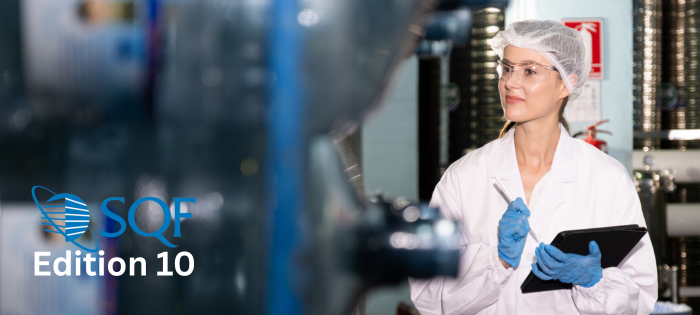
Comments: No Comments
SQF Edition 10 Delayed
Earlier in 2025, the Safe Quality Food Institute (SQFi) announced it would be releasing Edition 10 of its Safe Quality Food (SQF) Code to align with the latest Global Food Safety Initiative (GFSI) benchmarking criteria, updated regulatory requirements, and scientific changes. The publication date was targeted for September 2025, with audits beginning in April 2026. However, SQFi recently announced that the release of SQF Edition 10 has been delayed due to an extension in the GFSI benchmarking application timeline, which now runs through March 2026.
Because of this delay, SQF Edition 9 will remain the recognized version of the SQF Code. This means that audits will continue under the requirements of Edition 9 until Edition 10 is released. At that point, sites will have a six-month transition period before audits begin under Edition 10.
As KTL reported this summer, the SQF Edition 10 changes remain focus on three critical areas: food safety culture, change management, and environmental monitoring. SQFi has reinforced that, when released, the Edition 10 changes will reflect the industry’s growing understanding that food safety is not just about compliance, but about creating a holistic, proactive approach to protecting consumers.
With the additional time before the release and implementation of Edition 10, now is an ideal time for facilities who are certified to SQF to assess current SQF program elements, identify improvements that are internally desirable and required by Edition 10, and implement those updates that will make the SQF program more useful to the business.

Comments: No Comments
Gluten Added to Major Allergen Verification
The U.S. Department of Agriculture – Food Safety Inspection Service’s (USDA-FSIS) directive, Ongoing Verification of Product Formulation and Labeling Targeting the Nine Most Common (“Big 9”) Food Allergens, provides instructions to inspection program personnel (IPP) to verify that establishments are controlling and labeling the Big 9 food allergens in meat, poultry, and egg products. On September 11, 2025, USDA-FSIS reissued the directive to include gluten to be verified as an ingredient of public health concern.*
Why Gluten?
Gluten is a protein found naturally in wheat, rye, and barley. Many products contain gluten. According to the USDA, if meat, poultry, or egg products contain any of the following, they likely contain rye or barley and, subsequently, gluten:
- Malt extract
- Malt vinegar
- Rye flour
- Whiskey
- Malt flavoring
- Brewer’s yeast
- Barley flour
- Beer
- Malt syrup
- Yeast extract
- Soups
- Malted milk
- Spent grains
- Brown rice syrup
The National Institute of Health (NIH) estimates there are approximately two million Americans and one percent of the population worldwide who have celiac disease, an auto-immune disease triggered by consuming gluten-containing foods—plus many more with gluten sensitivities and intolerances. As such, the USDA considers gluten an ingredient of public health concern; however, it is not designated a Big 9 major food allergen (though wheat is). Even so, the updated USDA-FSIS directive now requires IPP to verify that establishments are accurately controlling and labeling gluten similarly to the Big 9 allergens.
Formulation Verification
The USDA-FSIS conducted analyses of voluntary recalls connected to undeclared allergens and determined the following:
- Many voluntary recalls occurred due to changes in ingredient suppliers, products in the wrong package or with misprinted labels, or changes to the product or ingredient formulation.
- Establishments failed to include allergens on the product label when product came into contact with an undeclared allergenic ingredient that was not directly added to the product (i.e., unintentional adulteration of product).
When an establishment allows product to enter commerce with undeclared allergens, it signifies that the food safety system has failed in some way to control the hazards associated with the allergens. As such, the purpose of the Big 9 Formulation Verification task is to verify that establishments are properly labeling the Big 9 major food allergens and gluten when included in the formulation of a product to avoid these issues.
During the Big 9 Formulation Verification task, IPP verify the following:
- The establishment has developed and implemented preventive or control measures in its Hazard Analysis and Critical Control Points (HACCP) Plan, Sanitation Standard Operating Procedures (SSOPs), and/or other prerequisite programs (PRPs) to address allergens.
- All ingredients used in the production of the product are present on the product formulation record.
- All ingredients in the product formulation are declared in the ingredient statement on the product label by common name in descending order of predominance.
- All ingredients listed on the labels of incoming food and food ingredients are also listed on the labels of the products in which they are used.
- All ingredients listed in a “may contain” or “produced in a facility” statement on incoming food and food ingredients are also listed on the final product label, except when the establishment contacts the supplier for further clarification and addresses the statement in the hazard analysis.
- The appropriate label is applied to the product.
- The applied label is consistent with the establishment’s label approval on file.
If IPP find that a product contains one of the Big 9 allergens or gluten that is not declared on the final label, they document a food safety labeling noncompliance in a Noncompliance Record (NR).
The Big 9 Formulation Verification task is conducted monthly; however, frequency may increase if there are indicators of an increased risk related to the Big 9 allergens, gluten, ingredients of public health concern, or other undeclared ingredients linked to the establishment, including the following:
- Public Health Alert (PHA) or recall.
- Consumer complaints.
- History of sanitation and/or HACCP NRs.
- History of labeling NRs.
- Recent product formulation changes, adjustments to ingredients, supplier changes, or new products added by the establishment.
Questions to Ask
The USDA-FSIS cautions that these updates do not change the fact that all ingredients, other than processing aids, whether allergens or not, must be declared on the label.
If you produce meat, poultry, and/or egg products, it is important to understand what allergens—and now gluten—you have at your facility, how you use them in product formulation, and how you label them as ingredients in your products. The USDA-FSIS outlines the following questions for the Big 9 Formulation Verification task that you can ask internally to ensure your products comply with labeling requirements:
- Which of the Big 9 allergens and/or gluten are included in products you produce at your facility?
- Does your facility use any components that have multiple ingredients that you do not produce or mix onsite?
- For the selected product, do you have any labels that claim the absence of one or more of the Big 9 allergens and/or gluten?
- For the selected product, do you implement control measures within your HACCP Plan, SSOPs, PRPs, or other programs to prevent misbranding (e.g., mistakes on labeling)?
- For the selected product, do you implement control measures within your HACCP Plan, SSOPs, PRPs, or other programs to prevent allergen cross-contact (e.g., food allergens from one product getting into another product that doesn’t contain the allergen)?
* Note: USDA-FSIS is also removing certain tree nuts that are no longer considered major food allergens from the directive, updating the milk category to include milk from other ruminant animals (e.g., sheep, goats), and updating the eggs category to include eggs from other fowl (e.g., duck, quail), in accordance with the Food and Drug Administration’s (FDA) January 2025 updates to food allergen labeling requirements.

Comments: No Comments
FSIS Publishes New HACCP Models
The U.S. Department of Agriculture (USDA) published the Pathogen Reduction; Hazard Analysis Critical Control Point (HACCP) Systems Final Rule (9 CFR 417.2(b)(1)) in July 1996, mandating all USDA-inspected meat and poultry establishments implement a system of controls to improve the safety of their products (i.e., a HACCP Plan). To assist in developing these HACCP Plans, the USDA Food Safety and Inspection Service (FSIS) developed a guidebook, accompanied by a generic HACCP model for each food processing category defined in the regulation. Recently, the FSIS published revised models for three different processing categories.
New Models
In June 2025, the FSIS released the two new generic HACCP models for egg products:
- HACCP Model for Pasteurized Liquid Egg Products (Fully Cooked – Not Shelf Stable Category), which includes pasteurized liquid whole egg, pasteurized liquid egg white, pasteurized liquid egg yolk, pasteurized scrambled egg mix products.
- HACCP Model for Dried Egg Products (Heat Treated Shelf Stable Processing Category), which includes spray-dried whole egg, spray-dried egg white, spray-dried egg yolk, spray-dried yolk, and whole egg blends products. This HACCP model illustrates the Heat-Treated Shelf Stable processing category with a dried egg product.
Published in August 2025, the HACCP Model for Ready to Eat (RTE) Fermented, Salt-Cured, and Dried Products (Not Heat Treated – Shelf Stable) applies to products that are cured, dried, or fermented as the sole means to achieve food safety and uses RTE dried fermented sausage as the example product. Products in this category are shelf stable and may be produced as RTE, including:
- Dried sausage, such as salami and pepperoni (if not heat-treated).
- Semi-dry sausages, depending on the process steps.
- Dried whole muscle products that are mostly dry cured, including dried hams (e.g., prosciutto, parma, and country ham) and dried intact pieces of meat (e.g., dried pork bellies (Pancetta), dried pork shoulders (coppa), and dried beef rounds (bresaola, beef prosciutto, and basturma)).
How HACCP Models Help
The generic HACCP models are written to help small and very small federal- and state-inspected establishments (SMEs) that produce meat, poultry and egg products develop their HACCP Plans. In essence, they help to:
- Translate FSIS rules and regulations into plain language and daily operational practices.
- Provide useful examples of how to meet the regulatory requirements.
Each HACCP model represents a food processing category, such as those outlined above. Each processing category may contain numerous products. The models include a product description, ingredients list, production flow diagram, hazard analysis, and HACCP Plan, as well as details regarding regulations and best practices to meet regulatory requirements.
Importantly, generic HACCP models are not intended to be used “as is”. Rather, they serve as examples that establishments must customize to fit the SME’s operations. For example, the model may lend ideas about which critical control points (CCPs) might be effective, offer guidance on the selection of critical limits, or help Food Safety Teams think more creatively about their processes and HACCP system.
While the generic HACCP models cannot guarantee a facility will meet all the regulatory requirements, they are an excellent resource and provide a solid foundation for developing a HACCP system that is focused on producing safe and wholesome products.

KTL Returns to the 2025 Food Safety Consortium
KTL will be joining the 2025 Food Safety Consortium in Arlington, VA, October 19-21, 2025, as a featured panelist and exhibitor. The 14th Annual Food Safety Consortium provides food safety and quality assurance professionals with cutting-edge knowledge, practical skills, and a collaborative network to enhance their professional development as champions of food safety.
KTL will be a panelist on the following breakout session as part of the workshop’s technical agenda:
Beyond the Checklist: Strengthening Supplier Verification for Transparency and Compliance
October 21, 2025 | 9:30-10:30 am | Panelist: Roberto Bellavia, Senior Consultant and Partner
In today’s dynamic regulatory environment, supplier verification is no longer just a documentation exercise—it’s a critical component of a resilient and transparent supply chain. This session will explore how food manufacturers, retailers, and foodservice operators are leveraging digital platforms, risk-based strategies, and FSMA-aligned best practices to ensure supplier compliance and mitigate potential disruptions. Learn how to build verification programs that go beyond minimum requirements to proactively manage risk, foster trust with trading partners, and adapt to evolving traceability expectations. Whether you’re preparing for FDA inspections or looking to streamline supplier onboarding and oversight, this session will equip you with actionable strategies to enhance both transparency and performance across your supply network.
And be sure to stop by and visit us at Booth #21. We look forward to seeing you at the Food Safety Consortium!

Comments: No Comments
FSSC Development Program
Every company has an obligation to its customers to provide safe, quality, and legal food. Certification under a Global Food Safety Initiative (GFSI)-recognized food safety management program is a growing requirement within key food product supply chains—one that is driven by customer/market demands. The GFSI system provides a high degree of confidence that food safety management systems (FSMS) are adequately designed, implemented, and maintained.
The requirements of the GFSI-benchmarked certification schemes can be complex, and the certification process can be long, especially for small and medium-sized enterprises (SMEs). Initiatives such as the FSSC Development Program can serve as an entry point for organizations to help implement a conforming FSMS without the additional challenge of achieving full certification.
What Is the FSSC Development Program?
The FSSC Development Program provides a flexible approach to food safety conformity, allowing SMEs to demonstrate to the food supply chain and their customers that food safety is a priority. The FSSC Development Program is aligned with Hazard Analysis and Critical Control Points (HACCP) according to CODEX Alimentarius, GFSI Global Markets, and the food safety elements of ISO 22000 and the related sector technical specifications.
The Program offers a series of clear steps to help organizations develop an effective FSMS and provides a pathway to achieve full FSSC 22000 certification, while building the maturity of the FSMS. The Program applies to SMEs in the following sectors:
- Food and feed manufacturing
- Catering and food service
- Retail, wholesale, and e-commerce
- Transport and storage
- Packaging (new as of May 2025 – see below)
How Does It Work?
FSSC outlines the following proposed steps for achieving conformity under the FSSC Development Program:
- Reflect: SMEs review the Program requirements and then complete a self-evaluation using the free Self-Assessment Checklists. Each sector listed above has its own checklist to assess sector-specific requirements. The self-assessment requires SMEs to consider their operations, focusing primarily on existing FSMS elements and prerequisite programs. A second-party auditor may provide additional value conducting this initial assessment.
- Prepare: Once the SME has completed the self-assessment and made appropriate changes, the organization will work with an FSSC Development Program Conformity Assessment Body (CAB) to schedule a complete assessment of the FSMS. The CAB will work with the SME to identify and help to address any nonconformities identified.
- Conform: After a successful assessment, the CAB will issue a Conformity Statement, including any corrective actions needed. This statement serves as evidence of improvements the SME has made toward achieving full certification. At this point, the organization will be listed on FSSC’s List of Conforming Organizations. To maintain conforming status, an annual assessment is required. Once the SME reaches this level, it can continue conforming to the Development Program or proceed toward attaining full FSSC 22000 certification.
What Are the Version 2.0 Updates?
For companies interested or already involved in the FSSC Development Program, Foundation FSSC released a series of improvements (Version 2.0) on May 20, 2025 to better support conformance. Based on the results of a global survey, FSSC updated the Program for the following reasons:
- Include Category I: Packaging in the Program’s scope.
- Adjust the duration of the conformity assessment to better suit SMEs.
- Provide enhanced support to participants, including guidance documents, training, and webinars.
- Increase the Program’s awareness and visibility throughout the marketplace and, correspondingly, strengthen acceptance of the Program throughout the supply chain (i.e., specifying organizations and large buyers).
The primary changes in Version 2.0 include the following:
- Transition to a single conformity level—versus two different levels—aligned with the current Level 2 in Version 1.1.
- Implementation of a full HACCP system aligned with ISO 22000, including critical control points (CCPs) and operational prerequisite programs (OPRPs).
- Shift from a question-based structure to a requirements-based structure in the self-assessment.
Assessments against Version 2.0 went into effect on June 1, 2025; however, conformity assessments against Version 1.1 may still be conducted until May 31, 2026, when everything will transition to Version 2.
Why Participate in the Program?
The FSSC Development Program is ideal for smaller organizations that want to develop and improve their FSMS but might not have the resources to achieve GFSI-recognized certification in one step.
- The Program provides SMEs with a flexible solution that aligns their conformity status to their food safety and business goals (e.g., meeting their clients’ food safety requirements or expanding their market access).
- Integrating the Development Program into vendor assurance programs helps larger food organizations ensure the food safety of their non-GFSI certified SME suppliers through an internationally recognized program.
- Conforming organizations are listed on the FSSC website, making it easy to share conformance status; this global recognition can support expansion into new markets.
- Alignment with the FSSC Development Program supports progression to GFSI certification, if desired, while building the maturity of the FSMS.

KTL to Exhibit at the 155th Congress of Correction
KTL will be exhibiting at the American Correctional Association’s 155th Congress of Correction in Denver, CO, August 21-26, 2025. The Congress features a wide array of workshops and sessions focused on cutting-edge topics for correctional facilities. The educational workshops feature the best in the business, passing on critical knowledge and engaging in important discussions, while the expansive exhibit allows attendees to interact with hundreds of companies serving the correctional industry.
Be sure to stop by and visit KTL at Booth #871. We look forward to seeing you at the Congress of Correction!

The Business Case for Second-Party Audits
All types of organizations and operational processes demand a variety of audits and assessments to evaluate compliance with requirements—ranging from government regulations, to industry codes, to management system standards (e.g., ISO, GFSI), to internal obligations. Audits and assessments capture regulatory compliance status, management system conformance, supplier compliance, adequacy of internal controls, potential risks, and best practices.
Internal audits help identify problems so corrective/preventive actions can be put into place and then sustained and improved prior to third-party certification/compliance audits. Internal audits and assessments also help companies with continuous improvement initiatives.
Understanding the Internal Audit Process
Many organizations conduct internal audits with their own staff to assess conformance and identify opportunities for improvement. For companies large enough to have a dedicated internal audit team (with have no ties to the processes they audit), this may make perfect sense. However, it can take significant resources—time, personnel, money—to conduct all internal audits with internal resources.
It is easy to underestimate what goes into a successful audit and assume that it is more efficient and cost-effective to use internal resources. But that often isn’t the case. Let’s consider what an internal audit entails.
Pre-Audit Preparation
- Research: Auditors must understand the standard they are assessing against (i.e., regulatory, management systems, internal, industry). Effective auditors will also understand industry best practices; related local, state, and/or country-based requirements; processing norms for new product areas; etc. that can impact operational compliance and risks.
- Logistics: Logistics includes coordinating with the facility(ies) to schedule the audit and time with applicable personnel for interviews and, if travel is required, researching/booking flights, booking hotels, arranging for car transportation, etc.
- Document Review: Prior to the onsite audit, auditors should review available documentation (e.g., procedures, policies, programs). This will better inform and guide them on where they should dig more deeply during the audit, as well as help them create effective audit protocol (see below). Pre-audit document review also allows the onsite portion of the audit to remain focused on observing operations, interviewing workers, and verifying physical requirements are being met.
- Audit Protocol/Template: Auditors need to take the time to develop protocol/questions for conducting the audit, as well as standardized reporting templates, before the site visit. A standard protocol will make conducting multiple audits more efficient. Consistent protocols and templates also add value by allowing for direct year-over-year and site-to-site comparisons.
Onsite Audit
- Technical Knowledge: To efficiently conduct an audit, auditors must have a thorough understanding of the standard they are assessing against. In many cases, auditors are asked to juggle multiple areas of focus at once. For example, in a foods facility, the auditor may simultaneously evaluate Food and Drug Administration (FDA), U.S. Department of Agriculture (USDA), Global Food Safety Initiative (GFSI), and facility-specific procedure requirements. For an environmental, health, and safety (EHS) audit, the auditor may simultaneously assess Environmental Protection Agency (EPA), Occupational Safety and Health Administration (OSHA), state agency, and facility-specific requirements. Deep technical knowledge of all the related standards and codes helps to ensure a thorough audit.
- Audit Tools: Having the right tool for the job can make audits significantly more efficient. This includes the audit protocol and templates developed as part of pre-audit preparation, as well as audit tools that may be used to conduct and manage audits more efficiently and effectively.
- Audit Management: Auditors are responsible for building a relationship of trust and openness with the facility quickly, while still maintaining control of the audit. This can be a challenge for internal auditors when interviewing colleagues and assessing internal systems.
Post-Audit Follow-up
- Report: Auditors need to synthesize observations from the audit to create a report that concisely conveys all pertinent information, including nonconformances with the defined standard(s). Auditors provide additional value when they can leverage their industry experience to prioritize findings and identify opportunities for improvement and best practices. Reports are most valuable when finalized within a few weeks of the site visit when information is fresh to facility staff.
- Corrective Actions: After an internal audit, facility staff will inevitably have questions regarding findings and what to do next. Auditors can provide valuable support by offering recommendations, building corrective action plans, and supplying technical guidance.
Many organizations do not have dedicated internal auditors—rather, internal auditing is an “add-on” responsibility—so time spent completing these internal audit activities takes time away from other business responsibilities. This often results in a post-audit period where the internal auditor has significant catchup to complete other work that has been put on the backburner while conducting the internal audit.
Value of a Second-Party Auditor
A second-party auditor can provide an objective assessment of overall compliance status and, in many cases, do it more efficiently than organizations are able to do with their own resources. A second-party auditor has the time required to conduct the audit, travel, review documents, and create a report. Beyond that, a second-party auditor also has audit tools and templates to create efficiencies when conducting the audit and reporting, can consolidate audit trips, and can spend dedicated time completing all audit activities as efficiently as possible without needing to factor in other business responsibilities.
Beyond saving significant resources, using a second party to conduct audits provides significant business value and additional return on investment:
- Objectivity: Enlisting a qualified outside firm to conduct an audit provides a fresh set of unbiased eyes to assess aspects of your program internal staff may not consider or see. Second-party auditors offer broad perspective and knowledge of best management practices from conducting audits across industries and standards. They maintain ongoing, up-to-date awareness of current and pending regulatory requirements that the organization should consider.
- Customizable: The audits themselves can be customized to fit the needs and goals of the organization. A second-party auditor can provide more direct coverage to evaluate specific program effectiveness and allow for a more focused understanding of existing strengths and improvement areas. Whether there is a desire to prepare for unannounced regulatory agency visits, review plans and programs, assess supplier compliance, or even verify applicability, second-party audits can be built to address the organization’s identified concerns and help manage risks.
- Effective Tools: Second-party auditors often bring effective audit tools to help conduct and manage audits. These tools capture regulatory compliance status and certification system conformance more efficiently, track audit progress/completion status by subject, and generate reports that can be used by management to inform decision making.
- Efficiency: Audits performed internally can take resources away from normal business operations not only when conducting the audit, but also when catching up on daily responsibilities and work that is set aside during the audit. Second-party auditors work with the resources allocated to them to conduct an audit in a timely manner that does not negatively impact business functions. These audits minimize the overall disruption in business compared to internal audits.
- Validation: Second-party auditors validate existing programs and identify areas where best practices can be implemented to further protect the company. They assist in identifying and prioritizing issues before they become violations—focusing on implementing and closing corrective actions. They also provide data and reports that can be shared internally with employees to improve performance or externally with communities or customers to bolster the company’s image.
- Consistency: Using the same second-party auditor to conduct your audits creates consistency across locations and over time. This allows the organization to establish a benchmark for performance that can be used to help ensure continuous improvement throughout the organization and its supply chain.
Second-party audits are not just about checking boxes—they are about building stronger partnerships, spotting issues early, and keeping your business running smoothly. Don’t wait for nonconformances to catch you off guard. Implementing second-party audits isn’t just a compliance tool, it is a strategic advantage.

Comments: No Comments
Training Update: PCQI V2.0
The Food Safety Modernization Act’s (FSMA) Preventive Controls for Human Food (PCHF) Rule (21 CFR 117) requires subject food facilities to develop and implement a robust Food Safety Plan that includes an analysis of hazards and risk-based preventive controls (PCs) to minimize or prevent those identified hazards.
One of the key requirements of the PCHF Rule is that certain activities be performed by a Preventive Controls Qualified Individual (PCQI) who is knowledgeable in the development and application of risk-based PCs. At least one PCQI is required at each subject facility, who is responsible for overseeing or performing the following:
- Preparation of the Food Safety Plan.
- Validation and verification of PCs and monitoring activities.
- Records review.
- Annual reanalysis of the Food Safety Plan.
PCQI Training Requirements
Becoming a PCQI requires knowledge in the development and application of risk-based PCs gained either through job experience or through training under a standard Food and Drug Administration (FDA)-recognized curriculum.
The Food Safety Preventive Controls Alliance (FSPCA) PCHF (PCQI) training curriculum, which includes minimum of 22 contact hours, is widely recognized by FDA and industry as the “gold standard” for food safety professionals to obtain the knowledge required to create a Food Safety Plan under the PCHF Rule.
A New Version
On June 30, 2025, FSPCA retired its previous (Version 1.2 (V1.2)) PCHF/PCQI training curriculum; as of July 1, 2025, FSPCA will only conduct and/or approve administration of its new Version 2.0 (V2.0) curriculum. V2.0 is designed to better equip participants with the most current tools and reference materials, new and updated guidance documents, and the latest strategies for managing Food Safety Plans and FDA compliance.
One of the most significant changes to the curriculum includes integrating the FDA’s new Hazard Analysis and Risk-Based Preventive Controls for Human Food draft guidance, which was released in January 2024. The curriculum expands the hazard analysis chapter to show participants how to use the guidance when performing a hazard analysis, takes a deeper dive into specific pathogens of concern for food, and offers more specific examples of chemical and physical hazards.
Other changes include the following:
- More modern format to improve clarity, including using QR codes to provide quick access to supporting documents and resources.
- Knowledge checks at the end of each chapter to help gauge participant understanding throughout training.
- Restructured to follow Hazard Analysis and Critical Control Points (HACCP) principles built on critical control points (CCPs) and expanded using PCs.
- Examples incorporating recent current events (e.g., recalls, economically motivated events).
- Updated model planning examples to support learning objectives.
- Clearer examples of how to document PCs.
Training Renewal
Individuals who received FPSCA training under PCHF/PCQI V1.2 do not need to re-complete the training course again to remain a PCQI. There is no FDA regulatory requirement to renew training to comply with the PCHF Rule. However, some customer and third-party requirements may require renewal.
Beyond requirements, taking the V2.0 course incorporates new FDA guidance information tools and may be valuable for any current PCQI to get new insights into the PCHF Rule and updated resources to help with compliance. All food safety professionals taking the FSPCA PCHF/PCQI course will be trained under the new V2.0 curriculum going forward.

Comments: No Comments
SQF Edition 10: On the Way
The Safe Quality Food (SQF) Program is a rigorous food safety and quality program. Recognized by the Global Food Safety Initiative (GFSI), the SQF codes are designed to meet industry, customer, and regulatory requirements for all sectors of the food supply chain. SQF certification showcases certified sites’ commitment to a culture of food safety and operational excellence in food safety management.
In mid to late August 2025, SQF will be releasing Edition 10 to align the code with the latest GFSI benchmarking criteria, updated regulatory requirements, and scientific changes. According to the SQF Institute (SQFi), SQF Edition 10 is designed to reshape how food manufacturers approach safety, culture, change management, and continuous improvement. Edition 10 is scheduled for implementation with audits beginning April 2026.
Key Updates
According to SQFi, Edition 10 represents a strategic evolution in food safety management, focusing on three critical areas:
- Food Safety Culture. Edition 9 elevated food safety culture by requiring senior leadership to lead and support a food safety culture within the site. Edition 10 aims to transform food safety from a procedural requirement to an organizational mindset by mandating robust Food Safety Culture Plans that demonstrate comprehensive strategies for the following:
- Effective communication.
- Comprehensive employee training.
- Systematic feedback.
- Continuous improvement.
- Change Management. Edition 10 implements a mandatory change management clause that requires organizations to develop documented procedures for handling all types of changes (i.e., equipment, processes, personnel). The intent is to help organizations better identify and manage risks and prevent potential incidents.
- Environmental Monitoring. Edition 10 requires a risk-based assessment to determine environmental monitoring needs. This will allow sites to develop monitoring strategies and programs based on their specific operational risks and environments.
In addition, Edition 10 includes the following updates:
- Documentation: Requirements for documentation are now contained in a single structured section to simplify compliance and improve auditor efficiency.
- Training: Edition 10 includes enhanced training and competency assessments so personnel at all levels understand and are prepared to maintain food safety standards.
- SQF pre-audit: The concept of pre-audits (i.e., internal audits) is reintroduced to help sites better prepare for certification.
Planning for Change
For companies that are SQF-certified, now is the ideal time to assess current SQF program elements, identify improvements that are internally desirable and required by the new standard, and implement those updates that will make the SQF program more useful to the business. This can be done through a series of phases to ensure adoption throughout the organization.
Phase 1: SQF Assessment
An assessment should begin by reviewing the following:
- Existing SQF programs, processes, and procedures.
- Existing document management systems.
- Employee training tools and programs.
This documentation review and program assessment will help to identify elements of the existing SQF program that are acceptable, those that show opportunities for improvement, and those that may be missing, including those needed for development and implementation to meet the requirements of SQF Edition 10.
Phase 2: SQF Program Updates
The assessment will inform a plan for updating the SQF certification program, including major activities, key milestones, and expected outcomes. Development/update activities included on the plan may include the following:
- Developing new or updating current SQF programs, processes, and procedures with missing Edition 10 requirements, including new procedures for change management and environmental monitoring.
- Updating training programs with any new and additional requirements, focusing on enhanced competency assessments.
- Revising document register to align with SQF Edition 10 changes.
- Updating records and forms with any new/additional requirements.
- Updating Food Safety Policy to include new food safety culture requirements.
When implementing program updates, leveraging existing management system and certification program elements and utilizing proven approaches can greatly streamline the process.
Phase 3: Training
To ensure staff are prepared to implement and sustain the updated SQF Edition 10 program, training is important. This includes training for affected staff on applicable requirements; specific plans, procedures, and Good Manufacturing Practices (GMPs) developed to achieve compliance; and the certification roadmap to prepare for future audits.
Following this plan now will help companies ensure they maintain their SQF certification when audits begin under SQF Edition 10 in April 2026 and demonstrate their ongoing commitment to meeting customer and regulatory requirements, protecting the company brand, and keeping consumers safe.

Comments: No Comments
Food Safety Regulatory Roundup
The food system and supply chains continue to change and evolve at an accelerated pace. The Department of Health and Human Services (HHS), Food and Drug Administration (FDA), and U.S. Department of Agriculture (USDA) have taken a number of significant food safety regulatory actions in the first quarter of 2025, including announcing HHS’s intent to explore potential rulemaking to eliminate the self-affirmed Generally Recognized as Safe (GRAS) pathway and proposing to extend the compliance date for the Food Traceability Rule by 30 months.
The regulatory landscape is shifting, and regulatory changes continue to come fast and furious. The following recent actions (amongst others) have the potential to significantly impact food companies across the U.S.
Updated Allergen Guidance
On January 6, 2025, the FDA published a revised fifth edition of its food allergen guidance for industry, Questions and Answers Regarding Food Allergens, including the Food Allergen Labeling Requirements of the Federal Food, Drug, and Cosmetic Act. The guidance is intended to help the food industry meet requirements for accurately labeling FDA-regulated foods with the big 9 food allergens (i.e., milk, eggs, fish, crustacean shellfish, tree nuts, wheat, peanuts, soybeans, and sesame) to protect consumers with food allergies.
The guidance includes updates reflecting FDA’s current thinking on food allergen labeling topics, including the following:
- Information regarding sesame as a major food allergen.
- Expanded interpretations of milk and eggs as major food allergens to include milk from ruminant animals other than cows and eggs from birds other than chickens.
- Adjustments to remove certain tree nuts, including coconuts, from the list of major food allergens.
Companies should reference the updated guidance to ensure they understand these changes, accurately evaluate the food safety and allergen risks of their products, and update manufacturing and labeling practices to remain in compliance with food allergen labeling requirements.
Withdrawal of Salmonella Framework
On July 29, 2024, the USDA Food Safety and Inspection Service (FSIS) issued its proposed rule and determination to more effectively reduce Salmonella contamination and illnesses associated with raw poultry products. The proposed framework presented a systematic approach to addressing Salmonella contamination at the poultry slaughter and processing stages, including the first enforceable standards to prevent raw chicken carcasses, chicken parts, ground chicken, and ground turkey products that contain any type of Salmonella at or above 10 CFU per gram/mL from entering the market. It also required poultry companies to establish microbial monitoring programs (MMPs) incorporating statistical process controls (SPCs) to identify and prevent pathogen contamination throughout the slaughter system.
FSIS received over 7,000 public comments on the proposed framework and announced a Notice of Withdrawal on April 25, 2025, retracting the proposed rule and determination to allow the Agency to further assess its approach. FSIS cites the following areas as garnering the most comments—both positive and negative:
- FSIS’s legal authority to propose final product standards.
- Proposed Salmonella levels and serotypes for the final product standards.
- Proposed use of SPC monitoring.
- Scientific and technical information used to support the proposed framework.
- Potential economic impacts.
- Potential impacts on small poultry growers and processors.
The comments also suggested several alternative approaches to address Salmonella illnesses associated with poultry products. FSIS is taking all of this under advisement as it reassesses its approach to Salmonella and whether an update to the current standards is warranted.
Phasing Out Synthetic Dyes
HHS and FDA announced on April 23, 2025 that they are taking immediate action to phase out eight petroleum-based synthetic dyes in foods and to fast-track review and approval of natural alternatives. These dyes are found in hundreds of products, including candy, cereals, beverages, and even medications.
Many synthetic dyes currently used in the U.S. have been banned or restricted in the European Union since 2010. In November 2023, California became the first state in the U.S. to ban four food additives (Red No. 3, brominated vegetable oil, potassium bromate, and propylparaben) in foods sold in California through the California Food Safety Act, and in March 2025, West Viriginia signed one of the most comprehensive food dye bans into law. Now the FDA is taking the following significant actions to remove synthetic dyes from all U.S. products:
- Establish a national standard and timeline for the food industry to transition from synthetic dyes to natural alternatives.
- Revoke authorization of Citrus Red No. 2 and Orange B in the next few months.
- Work with industry to remove the remaining six synthetic dyes from the food supply by the end of 2026. This includes FD&C Green No. 3, Red No. 40, Yellow No. 5, Yellow No. 6, Blue No. 1, and Blue No. 2.
- Fast-track authorization of four new natural color additives, including calcium phosphate, Galdieria extract blue, gardenia blue, and butterfly pea flower, and accelerate review of others.
- Partner with the National Institutes of Health (NIH) to further research how food additives impact children’s health.
- Request food companies remove FD&C Red No. 3 sooner than the January 15, 2027 or January 18, 2028 deadlines established by FDA on January 15, 2025.
The FDA is planning to proceed without any statutory or regulatory changes, relying instead on the voluntary efforts of the food industry in complying. The Agency is taking steps to issue guidance and provide regulatory flexibility to industry to remove the synthetic dyes as quickly as possible from the market.
In most cases, companies will need to:
- Inventory existing products and their ingredients to determine which products use synthetic dyes.
- Reformulate affected products to use natural color alternatives, test new recipes, and, potentially, make other recipe changes.
- Identify and approve new suppliers of alternative ingredients.
- Update label design, adjust ingredient panels, and modify any relevant nutritional claims.
Stay Focused
Change is happening, and companies in the food industry need to pay attention and be prepared:
- Conduct a comprehensive food safety and quality gap assessment. Know your operations, inventory your ingredients, understand your supply chain. This assessment should be the starting point for understanding your regulatory and certification obligations and current compliance status—and for ensuring you are prepared to meet pending regulatory developments.
- Train your staff. Every change discussed above requires employee understanding. Train your team routinely on requirements, responsibilities, processes, expectations, etc.
- Seek third-party oversight. Having external experts periodically look inside your company can help determine regulatory applicability, provide an objective view of what is really going on, prepare for audits, and implement corrective/preventive actions that help ensure compliance. An outside expert can often provide the “big picture” view of what you have vs. what you need; how your plans, programs, and requirements intersect; and how you can best comply with changing requirements.
